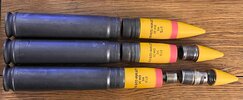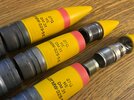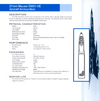From the markings I presume both are UK produced projectiles, such as Royal Ordnance/BAE Systems? This as I can see (presumed roll) stamps on the body of the projectile, which start with CY and RG. I can't see the fuze (it's not 'fuse' by the way) markings, or the markings on the cases, so can't make any guesses as to what their country of manufacture was.
As to the filling, if they are UK-produced, then they were likely filled with Hexa; a mix of RDX, powdered aluminium, and commonly a small amount of a phegmatizer (wax), and/or graphite. As Hexal is a high explosive incendiary (HEI) type of filling, this would be a good reason why a red band is present.
That being said, even though filled with Hexal, the Royal Ordnance/BAE Systems brochure I have from the late 1990s lists the rounds as HE. A screen capture of the brochure page is below.
View attachment 198768
The nose fuze mentioned in the brochure is the DM401 electromechanical delayed-action model.







